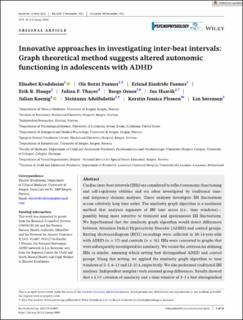| dc.contributor.author | Kvadsheim, Elisabet | |
| dc.contributor.author | Fasmer, Ole Bernt | |
| dc.contributor.author | Fasmer, Erlend Eindride | |
| dc.contributor.author | Hauge, Erik Rønneberg | |
| dc.contributor.author | Thayer, Julian F. | |
| dc.contributor.author | Osnes, Berge | |
| dc.contributor.author | Haavik, Jan | |
| dc.contributor.author | Koenig, Julian | |
| dc.contributor.author | Adolfsdottir, Steinunn | |
| dc.contributor.author | Plessen, Kerstin J. | |
| dc.contributor.author | Sørensen, Lin | |
| dc.date.accessioned | 2022-09-09T12:54:04Z | |
| dc.date.available | 2022-09-09T12:54:04Z | |
| dc.date.created | 2022-05-20T09:52:38Z | |
| dc.date.issued | 2022 | |
| dc.identifier.issn | 0048-5772 | |
| dc.identifier.uri | https://hdl.handle.net/11250/3016927 | |
| dc.description.abstract | Cardiac inter-beat intervals (IBIs) are considered to reflect autonomic functioning and self-regulatory abilities and are often investigated by traditional time- and frequency domain analyses. These analyses investigate IBI fluctuations across relatively long time series. The similarity graph algorithm is a nonlinear method that analyzes segments of IBI time series (i.e., time windows)—possibly being more sensitive to transient and spontaneous IBI fluctuations. We hypothesized that the similarity graph algorithm would detect differences between Attention-Deficit/Hyperactivity Disorder (ADHD) and control groups. Resting electrocardiogram (ECG) recordings were collected in 10–18-year-olds with ADHD (n = 37) and controls (n = 36). IBIs were converted to graphs that were subsequently investigated for similarity. We varied the criterion for defining IBIs as similar, assessing which setting best distinguished ADHD and control groups. Using this setting, we applied the similarity graph algorithm to time windows of 2–5, 6–13 and 12–25 s, respectively. We also performed traditional IBI analyses. Independent samples t tests assessed group differences. Results showed that a 1.5% criterion of similarity and a time window of 2–5 s best distinguished adolescents with ADHD and controls. The similarity graph algorithm showed a higher number of edges, maximum edges and cliques, and lower edges10+10/edges2+2 in the ADHD group compared to controls. The results suggested more similar IBIs in the ADHD group compared to the controls, possibly due to altered vagal activity and less effective regulation of heart rate. Traditional analyses did not detect any group differences. Consequently, the similarity graph algorithm might complement traditional IBI analyses as a marker of psychopathology. | en_US |
| dc.language.iso | eng | en_US |
| dc.publisher | Wiley | en_US |
| dc.rights | Navngivelse 4.0 Internasjonal | * |
| dc.rights.uri | http://creativecommons.org/licenses/by/4.0/deed.no | * |
| dc.title | Innovative approaches in investigating inter-beat intervals: Graph theoretical method suggests altered autonomic functioning in adolescents with ADHD | en_US |
| dc.type | Journal article | en_US |
| dc.type | Peer reviewed | en_US |
| dc.description.version | publishedVersion | en_US |
| dc.rights.holder | Copyright 2022 the authors | en_US |
| dc.source.articlenumber | e14005 | en_US |
| cristin.ispublished | true | |
| cristin.fulltext | original | |
| cristin.qualitycode | 2 | |
| dc.identifier.doi | 10.1111/psyp.14005 | |
| dc.identifier.cristin | 2025877 | |
| dc.source.journal | Psychophysiology | en_US |
| dc.identifier.citation | Psychophysiology. 2022, 59 (6), e14005. | en_US |
| dc.source.volume | 59 | en_US |
| dc.source.issue | 6 | en_US |

